Tags
American magpie, Bald eagle, BBC, BBC Wildlife magazine, Bighorn sheep, Bison, Cooke City, coyote, Don Hartman, elk, Golden eagle, Great grey owl, Jackson Hole, Lamar River, mountain goat, Natural Habitat, Raven, red fox, Rick McIntyre, Silver Gate, tracking wolves, Yellowstone, Yellowstone National Park
USA 2018 (13), Wolves? It was still dark – and minus 33ºC/minus 28ºF – when we set off at 7 a.m., to look seriously for wolves on this Tuesday morning, 20th February. After all, the name of the trip was ‘Yellowstone: Ultimate Wolf and Wildlife Safari’. We were essentially retracing the last part of our journey the day before, westwards from Cooke City, which is just outside the north-east corner of Yellowstone National Park, back along the Lamar valley, and then continuing parallel with the Yellowstone River westwards a little further. At our first stop, where we looked in vain for a wolf pack before the sun had even risen above the mountains, we saw water vapour rising from the creek, as if a hot sun were evaporating the water prior to a scorching hot day! But I was told it was case of thermal inversion.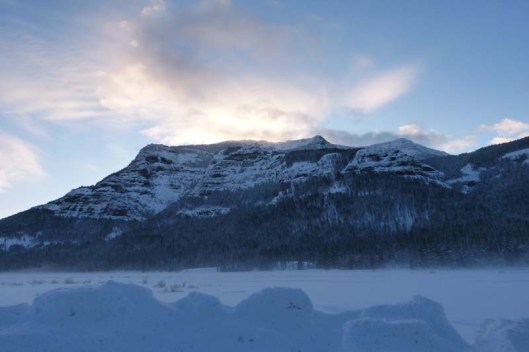
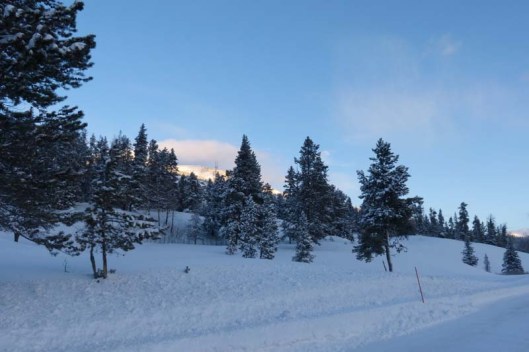 Our next stop, for ‘comfort’ purposes, was in yet another beautiful spot.
Our next stop, for ‘comfort’ purposes, was in yet another beautiful spot.
 Then we pulled up again, when we saw a group of photographer tourists parked and looking upwards – at four sleeping coyotes, of which here are two.
Then we pulled up again, when we saw a group of photographer tourists parked and looking upwards – at four sleeping coyotes, of which here are two.

Female bighorn sheep. Unusually, the female of this species has horns, but this one is lacking one of them.

Female bighorn sheep encounters bison, with no untoward outcome
We arrived at the furthest point intended for the day, where there was a good chance, we were told, of seeing a given pack of wolves. We met Lizzie, who spends much of her time tracking the animals. She passed round a collar which had been round a wolf’s neck, and that felt quite spooky to me. It was pretty heavy, and we were reminded that the wolf is a very large animal, though it’s difficult to realise when you see them from a distance – IF ever we should see them, from a distance or no. No luck this morning and we made our way back to Cooke City for lunch, quite slowly as we kept seeing interesting things and stopping.
She passed round a collar which had been round a wolf’s neck, and that felt quite spooky to me. It was pretty heavy, and we were reminded that the wolf is a very large animal, though it’s difficult to realise when you see them from a distance – IF ever we should see them, from a distance or no. No luck this morning and we made our way back to Cooke City for lunch, quite slowly as we kept seeing interesting things and stopping.

The other two ‘sleeping’ coyotes

Icing sugar? Ice cream? Thick snow?
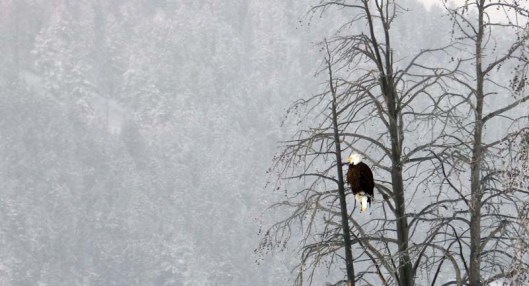
Bald eagle

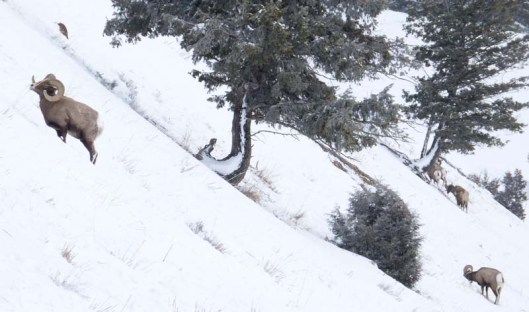
Male bighorn sheep


Pawing the snow aside to reach the vegetation. Despite appearances, it is the legs of the sheep which are vertical, not the camera crooked
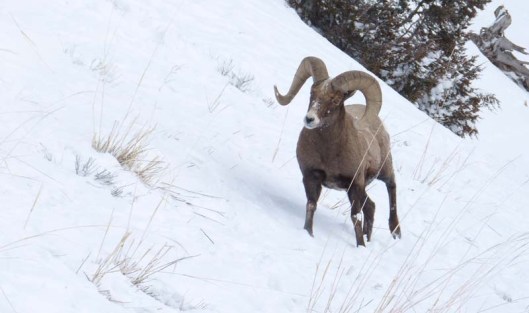

Ravens eating carcase, antler and vertebrae visible

Coyote

There is a tiny cream-coloured smudge in this photo, three-quarters of the way from the left and about a third down, below and to the right of the second big tree in from the right. It is at least two, perhaps three miles away, and is a mountain goat. Tim somehow spotted it for us.

Enlarging this photo further would just make the animal very blurry indeed.

Cooke City
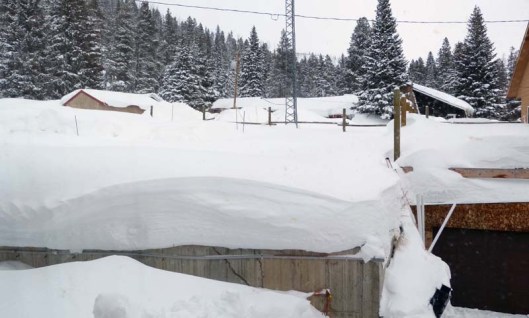
The view from my room, not seen in the dark the night before or in the morning
Plans for the afternoon were to meet a wildlife cinematographer, and then to have an individual choice between: resting for a while, going snow-shoeing, or further wildlife searching. Most people seemed to be going to opt for the last, including me. But then all plans changed. Wolves had been seen, where we had been that morning. So we ‘rushed’ off there, as safely as we could, but even so it took about an hour. En route we saw…

Male Bighorn sheep, presumably the same we had seen before lunch

A red fox, the only one all week. (Just how do these animals survive?)

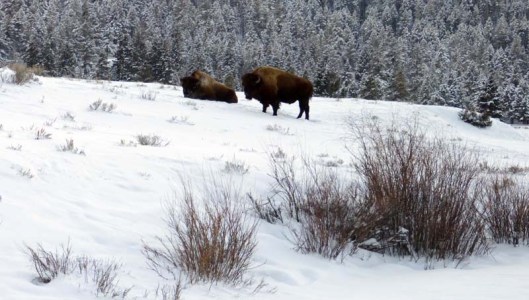
And more bison. So difficult not to take photos of them.
Arrived at the same spot as the morning, we met Rick McIntyre, who gave us a fascinating talk on the ecology of the animal. [PS, three weeks later. Rick is featured in a fascinating article on one of the Yellowstone wolves in the March edition of ‘BBC Wildlife Magazine’.] But the wolves had gone. ‘Hang on, there they are!’ the cry rang out from one of the leaders (now three as Tim from Nat Hab had joined us.). A very, very long way away. I was not the only one not to see them, whether through binoculars, cameras, or telescopes. Try, try and try, no, we just couldn’t. Moreover, it was said they were disturbing elk and bison, which would have been even more fascinating to see. But no, not many of us saw them. Not us amateurs anyway. I took several photos of where we were meant to be looking, hoping to blow them up and at least see them on my screen.
But the wolves had gone. ‘Hang on, there they are!’ the cry rang out from one of the leaders (now three as Tim from Nat Hab had joined us.). A very, very long way away. I was not the only one not to see them, whether through binoculars, cameras, or telescopes. Try, try and try, no, we just couldn’t. Moreover, it was said they were disturbing elk and bison, which would have been even more fascinating to see. But no, not many of us saw them. Not us amateurs anyway. I took several photos of where we were meant to be looking, hoping to blow them up and at least see them on my screen.

Not here

But here, on maximum zoom
No such luck. ‘They’ve gone now’. We left the scene, and made our way back towards Cooke City.

Golden eagle and American magpie on carcase

- Fleeting glimpse of an elk which had not made its way to the refuge at Jackson Hole, 100 miles or so to the south
However, we stopped at Silver Gate, just a short distance from Cooke City (not a city but more a large village, by the way). Our stop there was to meet the very patient Don Hartman. But then wildlife photographers are used to being patient.
I was especially thrilled to meet him. In post (5) of these USA 2018 posts, I mentioned that there had been a second BBC series on Yellowstone just before I left for the trip. Don Hartman had taken its amazing footage on the Great Grey Owl family through the seasons. He show us some of this footage, some more which didn’t make the cut, and other work of his, then answered many questions. What a surprise and privilege to meet him, and here he is.
It was dark as we left for another good meal in Cooke City. But a little warmer (!) as we bade each other goodnight, minus 25ºC/minus 13ºF.
[My apologies for the changes of type, which I have no idea how to correct. Retyping has made no difference. Any advice from fellow WordPress bloggers would be gratefully received.]

Sorry the wolves were too far away to photograph successfully but you caught many other animals and birds. I loved the bighorn sheep in particular.
LikeLike
Yes, they were a nice surprise.
LikeLike
What a lovely bonus to meet the photographer – some consolation for missing the wolves – although I would have assumed the coyotes were wolves! The goats are amazing – keep making me want to adjust the picture!
LikeLiked by 1 person
I even doubted my own pictures!
LikeLike
My website is WordPress – and I haven’t a clue how to work it since my guru abandoned me to do it myself. And if I try to click ‘like’ here it asks me to log in to my account – so I depart defeated!
LikeLike
‘Fraid I can’t help you there!
LikeLike
Ah well, you had many consolations.
LikeLiked by 1 person
Ooh, yes!
LikeLike
I”m so enjoying your blog! It truly is like re-living the trip, and I’m so happy to see your photos of the rotund nuthatch near the mud pots and the red fox, neither of which I got (too delighted just watching them!). Thank you.
LikeLike
Glad you’re enjoying reliving the trip Pam. So am I!
LikeLike
Gosh, what an incredible landscape.
LikeLike
Snow, snow, thick thick, snow…
LikeLiked by 1 person
That was a bonus, meeting Don Hartman. Sorry about not seeing the wolves, but you had plenty of other interesting sights. How do the animals survive!
LikeLiked by 1 person
Nature is amazing!
LikeLike
I love the red fox and the verticality of the bighorn
LikeLike
Those sheep have very strong ‘shoulder’ and ‘thigh’ muscles as you can see, and you can see why also!
LikeLike